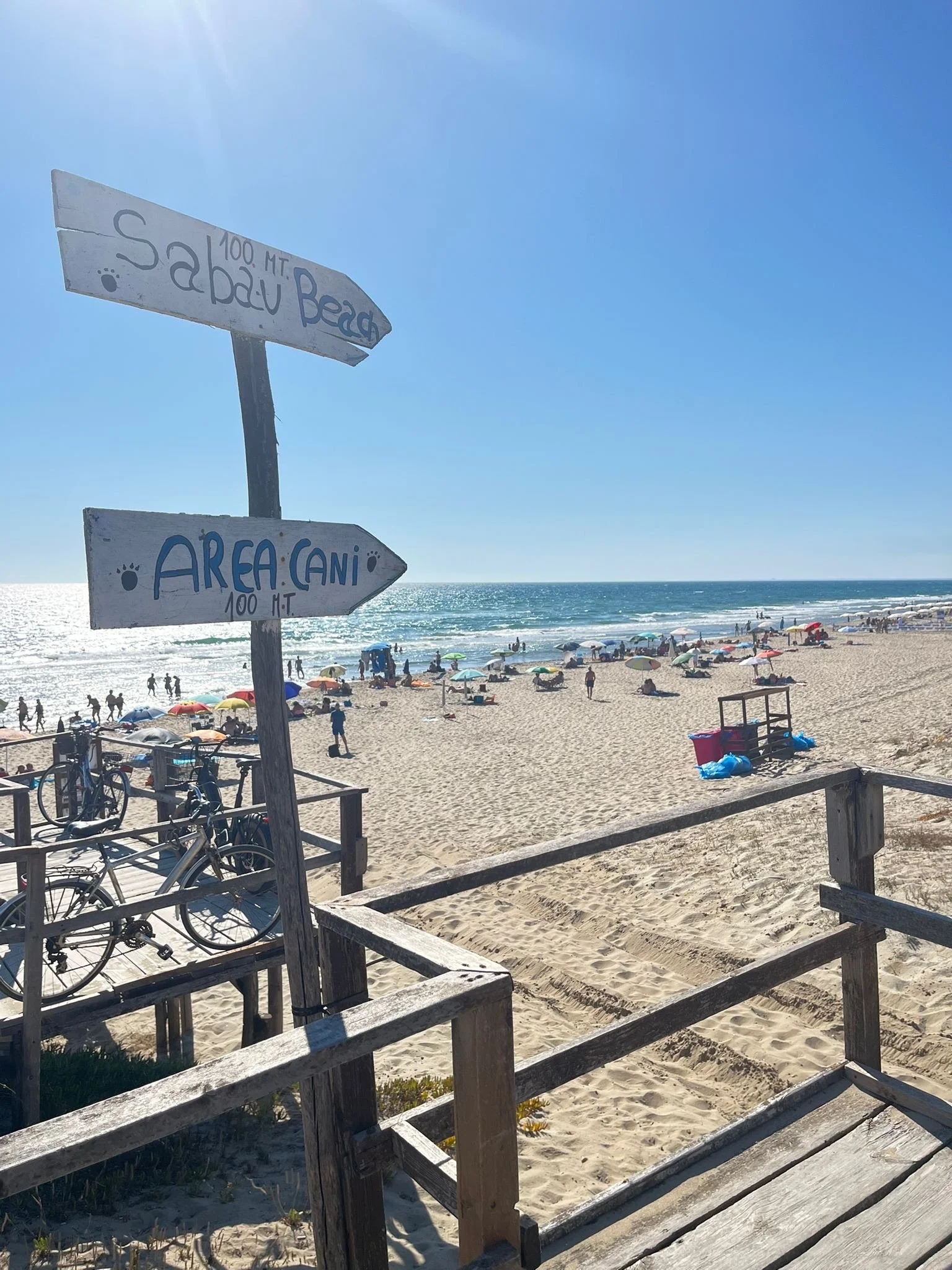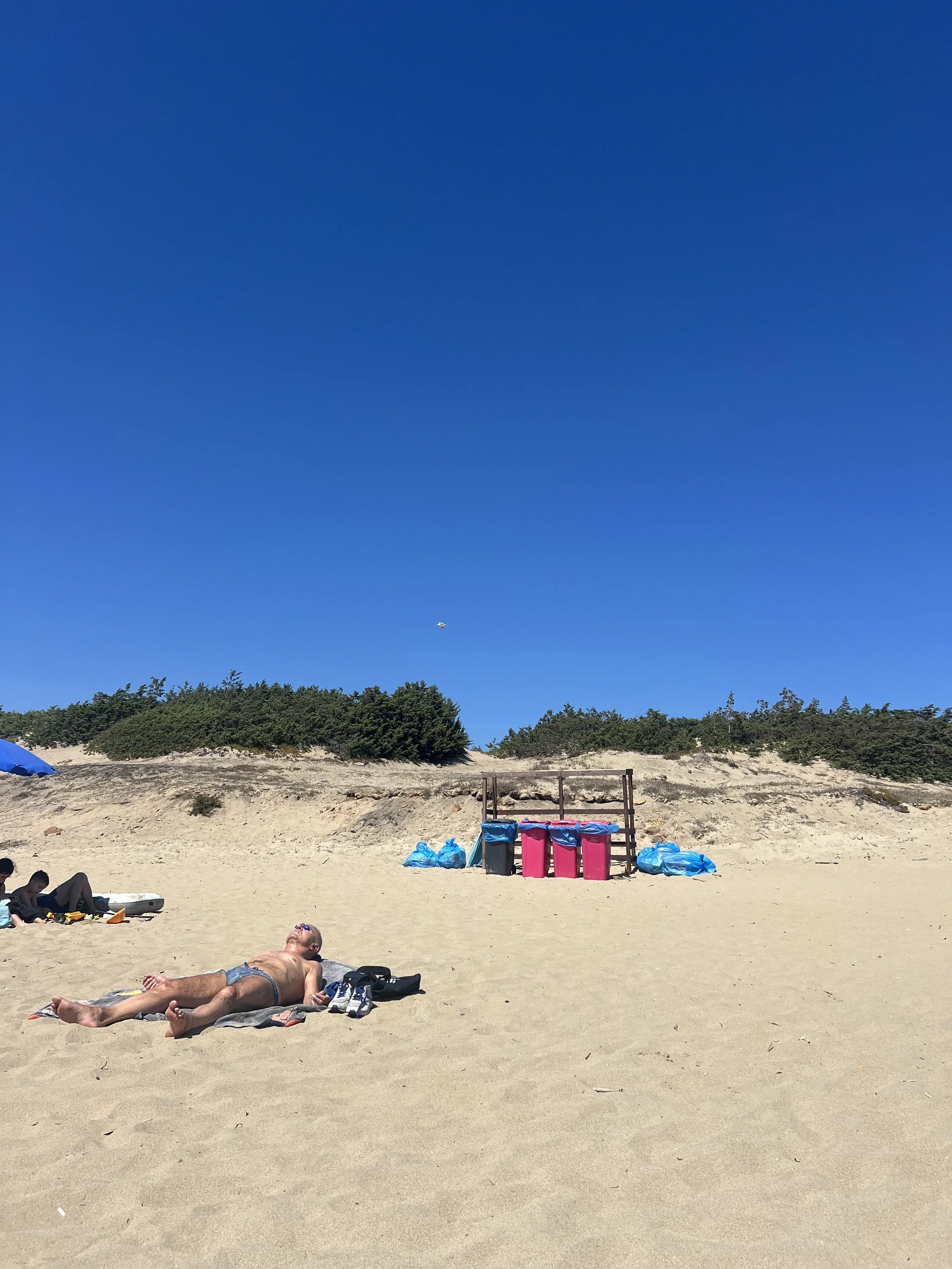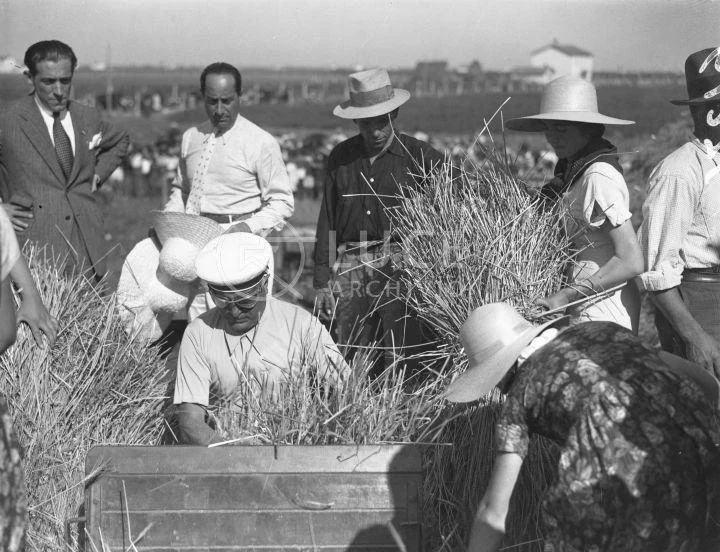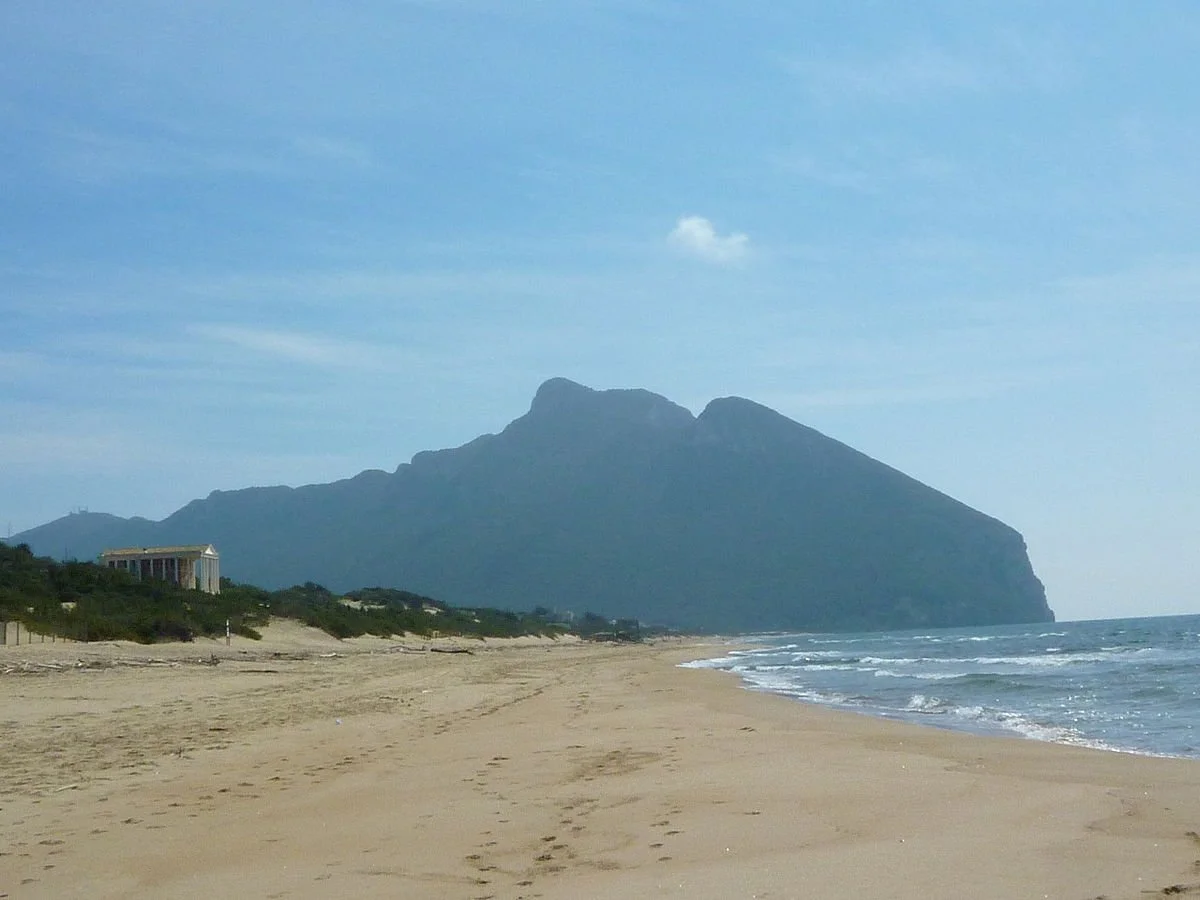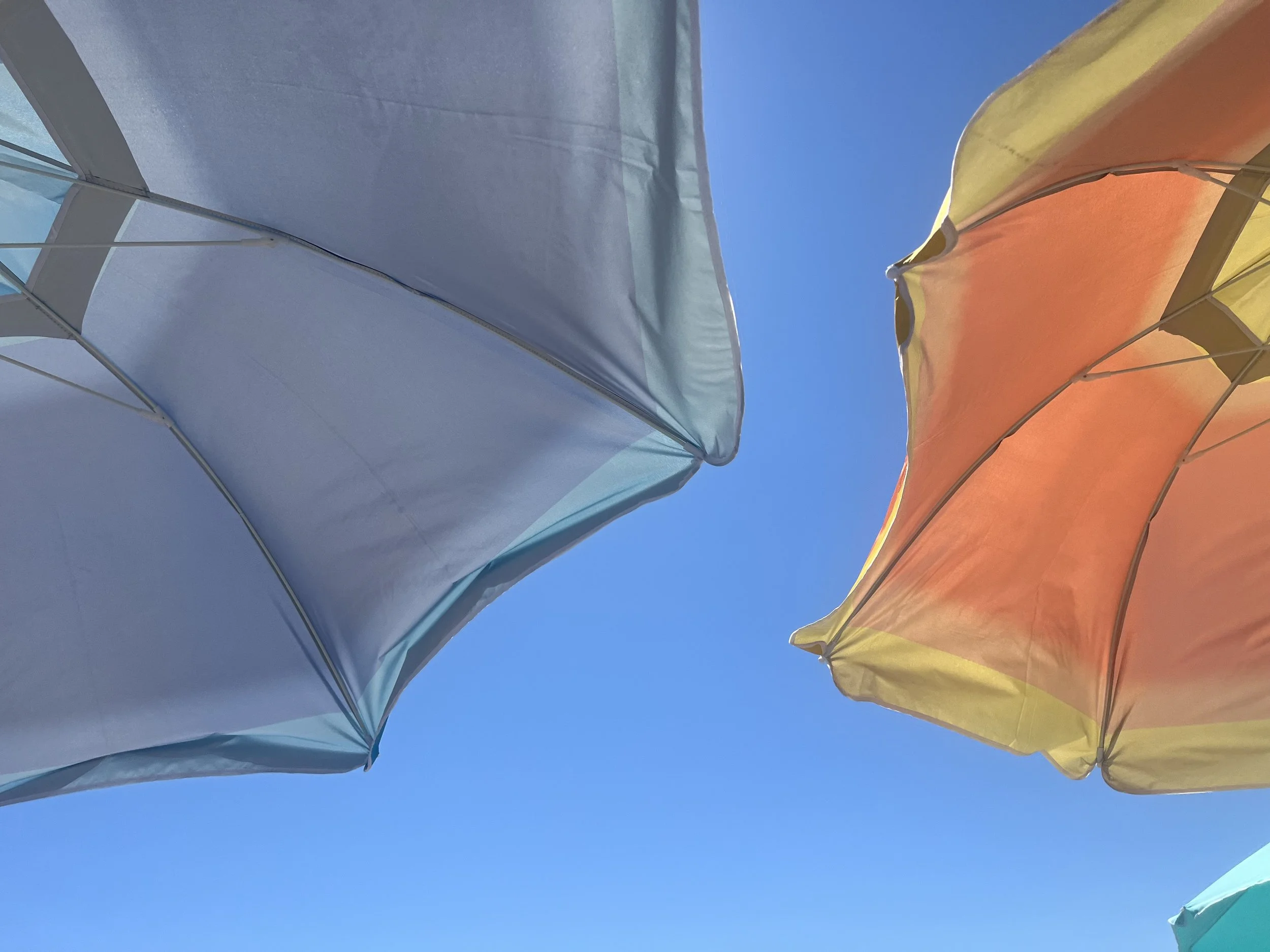Sabaudia Beach: Built by Mussolini, made famous by fellini
Summer in Lazio rewarded Marco and me with warm days yet stole serenity with crowds. Every weekend, we’ve been zig‑zagging the coast searching for a stretch of sand that felt like ours. Ostia promised convenience; it delivered concrete, litter, and the hum of traffic piercing every wave. One Sunday, cheeks flushed with disappointment, we pointed the car south, past the Pontine marshes, until a sign whispered “Sabaudia.” A pine‑scented breeze slipped through the window and we sensed we’d crossed an invisible border—from chaos into calm. What awaited was a beach both gentle and grand, able to hush the mind and stir the heart.
Chasing Quiet Water
Nestled along the sun-kissed Tyrrhenian coast of Lazio, Sabaudia Beach feels like a hidden world apart. Just an hour and a half south of Rome, the landscape transforms from urban bustle to pastoral quiet: flat green fields stretch out on either side of the road, punctuated by farmhouses and the occasional palm tree. It’s hard to imagine that this lush countryside was once malarial swampland a century ago – land not bestowed by the gods but reclaimed by human will in the 1930s, As we drive in, the air shifts. There’s the warm scent of hay and tilled soil from the farms, slowly giving way to a salty tang carrying on the breeze. I roll down the window; the summer air is hot but lifted by a gentle breeze, hinting that the sea is near. In the distance, looming above the plain, Monte Circeo rises like a guardian watching over the coast. Its silhouette is unmistakable. Locals say it looks like a woman lying on her back, face turned to the sky. Approaching Sabaudia, I feel a subtle excitement build. We are about to step into a place where myth and nature, past and present mingle by the shore.
The Drive In
There’s a point on the drive where the road crests a gentle hill and Sabaudia comes into view. Getting here is easy – roughly 90 minutes by car from Rome – yet it feels like crossing a threshold into a different era. The highway (the Pontina road) runs arrow-straight through the Agro Pontino plain, a patchwork of fields that were once the notorious Pontine Marshes. In summer, those fields glow green and gold. We pass roadside produce stands under umbrellas, piles of watermelons and corn reflecting the area’s agricultural bent. The feel is distinctly agrarian: tractors parked by ditches, rows of crops neatly planted, and the earthy fragrance of irrigation canals. Occasionally, we catch sight of a cow or buffalo grazing – a nod to the region’s transformation into fertile pastureland. It strikes me that this flat, fertile landscape is a deliberate creation: Mussolini’s 1930s project drained the swamps and built new farm towns here, including Sabaudia itself.
As we near the coast, clusters of tall maritime pines begin to line the road, their umbrella-like canopies shading the way. Beautiful villas start to appear, tucked behind gates and hedges. Some are low-slung white villette with red-tiled roofs, others modernist cubes half-hidden by oleander and palm trees. These homes signal we’ve reached the town’s outskirts. Even the light feels different now: brighter and clearer, reflected by the proximity of sand and sea. Through the open car windows, I catch a new scent layering over the farmland smells, a mix of pine resin and sea salt, resinous and sweet. There’s a rustling sound as the breeze plays with the pine branches, and I realize we’re also hearing the distant hiss of waves. The Tyrrhenian Sea itself is announcing its presence. With Monte Circeo’s limestone promontory now dominating the horizon to our right, we cross a short bridge over a glimmering lagoon – Lago di Paola, one of several coastal lakes that parallel the sea here. The lake’s surface is like glass in the afternoon heat, reflecting the sky. Fishermen’s boats and wooden docks float lazily at the edges. It’s a tranquil welcome, as if nature herself has arranged a grand entrance into Sabaudia.
The Town of Sabaudia
Sabaudia’s town center emerges gracefully, marked by clean lines and open space. Built in 1933 as part of Italy’s great land reclamation, the town has a unique atmosphere, a blend of rationalist architecture and coastal Italian charm. Driving into the main piazza, I immediately notice the geometric symmetry of the buildings. The bell tower of the Parrocchia Santissima Annunziata rises in minimalist elegance, and the Town Hall features straight columns and simple reliefs, hallmarks of 1930s design. There’s something poetic about how this very modern (for its time) architecture coexists with the wild natural park around it. Sabaudia feels both historic and timeless – its plan was modern, yet the mood is quietly nostalgic. The streets are broad and tree-lined, offering dappled shade to anyone strolling along the sidewalks. As we park and step out, heat radiates off the pavement in waves, but that breeze from the sea continues to temper it, carrying a hint of salt and maybe the fragrance of flowering shrubs from someone’s garden.
Walking through town, I’m struck by a sense of calm. It’s midday and many shops are closed for pausa pranzo, the afternoon break. In the sleepy hush, the cicadas have taken center stage. Their chorus emanates from the trees, a rhythmic soundtrack to the stillness. We wander down an avenue flanked by stone pines and modernist façades. Here and there, cafés spill onto the sidewalks, their awnings fluttering. Locals sip espresso or gelato, unhurried. I duck into a café for a quick espresso (per usual). The rich aroma and cool tiled interior are a welcome reprieve from the sun. The proprietor chats amiably about the weather and offers a recommendation for a beach trattoria later. There’s a friendliness in the air, a pride that this town, born from marshes, is now a beloved summer haven.
Even in its quiet, Sabaudia has character. The central square is anchored by a rationalist-style fountain, where a few children play, splashing their hands in the water. A line of flags flutters near the town hall – one of them the Blue Flag, signifying the pristine beaches and clean waters the area is known for. I recall reading that Sabaudia consistently earns this eco-label for its coastline, and standing here with the salty breeze in my hair, I can believe it. On the horizon beyond the town’s edge, you can just glimpse the dunes and the deep blue of the sea. Knowing that both the mountain and the sea are just minutes away gives the town a peculiar magic – a feeling of being gently enclosed by nature even as you stand among man-made structures. Sabaudia’s designers surely intended this harmony. As I take it all in, I feel the town inviting us to slow down and sync with its easy rhythm before we continue to the beach.
The Beach and Dunes
Monte Circeo stands guard at the far end of Sabaudia’s long, dune-backed beach
Leaving the town behind, we drive a short distance toward the litoranea coastal road. Almost immediately, the landscape turns wild again. On one side of the road stretches Spiaggia di Sabaudia – a seemingly endless ribbon of white-gold sand and on the other side lies the calm expanse of Lago di Paola and its sister lakes hidden by reeds. The beach is separated from the road by towering sand dunes covered in Mediterranean scrub. We park along the roadside and find a narrow path where a wooden boardwalk leads up and over the dunes. Climbing the dune, I run my hand through the coarse sand – it’s hot to the touch, grainy and fine, slipping between my fingers. Each step on the boardwalk releases a burst of scent as we brush past the hardy dune flora. Juniper bushes and mastic shrubs exhale a piney, herbal fragrance under the midday sun, and purple wildflowers peek out from the sands. The particular flora of these dunes (salt-loving grasses, sea lilies, and tamarisk) is uniquely adapted to this harsh, beautiful environment. When we crest the top, an awe-inspiring panorama unfolds: kilometers of unspoiled beach curve gently along the coast, flanked by the vivid blue sea on one side and the green lake shores on the other. In the distance to our left, Monte Circeo towers over the scene, its limestone cliffs meeting the water. To the right, the beach stretches so far that it melts into a hazy blue horizon towards Anzio.
There’s a natural grandeur here that takes my breath away. Despite being one of the swankiest summer resorts in Lazio, much of Sabaudia’s coast remains surprisingly wild and natural.
Soft dunes roll behind the beach, whispering with every breeze. We make our way to the shoreline, slipping off sandals to feel the sand. It’s soft and powdery near the water, studded with tiny shells that crunch underfoot. We find a spacious spot. The beach is long enough (about 15 kilometers) that it never feels too crowded. Families and groups of friends are scattered at comfortable distances, some under their own beach umbrellas, others at simple lidos with rented chairs. Children’s laughter carries on the wind, but the vastness of the beach absorbs most noise, so a peaceful hush prevails.
I spread out a towel near the foot of a dune, where a cluster of sea oats and beach grass provide a little natural privacy. The sun is strong, but that ever-present breeze keeps us cool, and occasionally a passing cloud gives a few moments’ relief. Behind us, the dunes and brush serve as a backdrop of nature. I spot a bright green lizard scuttling into a tuft of grass, too quick to photograph. Above, a few gulls wheel lazily, and I fancy I see a larger bird of prey gliding near the cliffs of Monte Circeo, maybe a peregrine falcon, known to nest in these parts.
It dawns on me that we are within a national park – Parco Nazionale del Circeo – which protects this entire mosaic of sea, dune, lake, and forest. The park is home to an astonishing variety of wildlife: wild boar and foxes in the woodlands, deer in the distant Selva di Circe forest, and over two hundred species of water birds that find sanctuary in the wetlands nearby. Though I don’t see these creatures directly, there’s an almost palpable vitality in the land, the knowledge that this place belongs to nature first and humans second.
Sabaudia’s beach also carries whispers of ancient myth. With a gaze toward Monte Circeo, I recall the legend: this very promontory is said to be the island of Aeaea, home of the sorceress Circe in Homer’s Odyssey. In the epic, Odysseus (Ulysses) landed on Circe’s island, and his men were enchanted and turned into swine by the sorceress before Odysseus, protected by a magic herb, won Circe’s favor.
Standing here, it’s easy to let the imagination roam. Monte Circeo indeed rises out of the sea like an island, connected to the mainland now by only a thin strip of sand and marsh, and scholars believe that in Homer’s time (over 2,700 years ago) it was effectively an island, encircled by sea and swamp. That rugged height covered in dense brush could well hide an ancient sorceress’s lair. In fact, one of the caves on the cape is still called Grotta della Maga Circe – Cave of Circe. I share a bit of this lore with Marco as we gaze at the mountain. It sends a delightful shiver up my sun-warmed spine to think we are lounging on the very sands that Odysseus’s crew might have walked, under the same mountain that has inspired tales for millennia. The mountain’s profile from here, broad and reclining, truly looks like a sleeping woman, perhaps the enchantress herself under a spell. With the waves softly lapping and the wild dunes at our backs, the scene feels enchanted in its own right. No wonder writers like Alberto Moravia loved to walk along this shore, finding inspiration in the meeting of Sabaudia’s wild beauty and its surreal, planned town, a contrast that also fascinated filmmaker Pier Paolo Pasolini, who shot films here. In this moment, I feel connected not only to nature and myth but also to the layers of human experience tied to this beach.
The Tyrrhenian Sea’s Embrace
After soaking in the sun for a while, the Tyrrhenian Sea calls to us irresistibly. I jog over burning-hot sand towards the water, feeling the grains give way into cooler, damp shoreline. The first touch of the sea on my toes is pure bliss, cool, crystal-clear water swirling around ankles, offering relief from the heat. We wade in slowly. The sea floor here is a gentle gradient; I can walk out many meters and still keep my head above water. Small translucent fish dart around in the shallows, flickering in the sunbeams that penetrate the water. When a bigger wave comes, I dive under and emerge with the taste of salt on my lips and the sting of saltwater in my eyes. Floating on my back, I let the gentle waves rock me. There’s an extraordinary clarity to this water. I remember reading that Sabaudia’s sea is rated among the cleanest in Italy (Blue Flag status year after year), and now I feel it. It’s so clear I can see the pattern of ripples in the sand below even where it’s chest-deep.
Lying buoyant in the sea, I look up at the vast blue sky. The only sounds are the soft crash of distant waves and the laughter of a child further down the beach, carried by the wind. I let my ears dip under the surface, and the world goes quiet except for the muffled roar of the sea – a sound that somehow manages to be both powerful and calming. In this semi-silence, my mind wanders. I think about how these same Tyrrhenian waters have seen the passage of ancient Greeks and Romans, of traders and fishermen, of travelers like me through the ages. The coast between Anzio and Terracina (right where we are) is steeped in history and legend. Perhaps even Aeneas, the Trojan hero, sailed along these shores in Virgil’s tales, and certainly many an ancient Roman galley passed by. What would they have thought of this place? I wonder. Maybe not much has changed. The promontory of Circeo would have looked the same, the sunsets just as golden, the sea breeze just as gentle on the skin.
I close my eyes and let the sunlight dance red across my eyelids. The water’s buoyancy holds me, as if the sea itself were cradling me in a cool embrace. There’s a subtle taste of salt on the breeze that brushes my face, mixed with the faint scent of marine pine from the shore. It’s a sensory tapestry: the cries of seabirds echo faintly, the touch of water like silk, the sight of endless blue merging with sky. Time loses meaning here. We spend what could be minutes or hours swimming, then floating, then simply standing waist-deep and talking about nothing and everything.
When we finally emerge and dry off, the late-afternoon sun has softened. The gentle wind coming off the water has kept us from feeling overheated despite the bright sun. That perfect mare e monti climate, where the sea and nearby mountains create a pleasant breeze cycle. I feel refreshed and renewed, as if the Tyrrhenian Sea washed away not just the sweat and sand but also the worries I carried. We sit for a while on the wet sand, letting the waves tickle our toes. Tiny sandpiper birds run near the foam, skittering away whenever a wave comes close, a little comical dance that makes us smile. We watch as the lowering sun casts a golden spell over the dune grasses behind us. The day is ripening into evening, and a few people are packing up their umbrellas, but there’s no rush for us.
Looking once more toward Monte Circeo, now gilded by the late sun, I feel a deep gratitude. Sabaudia Beach has given us more than just a day at the sea. It’s given us a dose of Italian nature, history, and serenity all at once. In one sweeping view we’ve had the mountain of legend, the ancient coastal forest, the quiet lagoons, and the shimmering sea. It’s a combination that makes this place feel almost otherworldly, yet it’s very much real and grounded. As we gather our things and make our way slowly back over the dunes, I inhale deeply to catch one last blend of sea salt, wild thyme, and warm sand in the air. I realize that Sabaudia has worked its subtle magic on me. In the warm glow of the evening light, with the promise of a cold aperitivo waiting back in town, I know this is a day I’ll carry in my heart – a personal strand woven into the long tapestry of memories and myths that live on this enchanting shore.
Simple Liberties: A Haven for Heritage Seekers
Sabaudia surprised us with freedoms rare on Italian coasts. Just before the shore lines are plenty of camping sites. Pitch beneath a starlit vault, lulled by surf, and greet dawn with bare feet already in warm sand—no pricey campsite barriers, no clinking keys for bathroom tokens. Respect the “leave no trace” ethos and the privilege endures.
Travelling with four‑legged companions? A clearly marked stretch designates a dog friendly beach Italy lovers applaud. Again, free. Watching tails carve joyous patterns in the shallows felt like witnessing summer distilled to its purest form.
Even the practicalities feel kind. Metered spaces near the dunes cost a touch over one euro per hour. Compared with the steep fees north of Rome, free parking beach Lazio may read like folklore, yet here it is: real, convenient, and merciful on the wallet.
Sabaudia is gentle on the eye, gentler on the mind. It lacks souvenir hawkers; instead, it offers quiet in which past and present can converse. In the hush of the ambiance, I realised heritage isn’t only in records or parish books. It lives in sensory moments: the sweetness of sun‑warmed figs, the hush before twilight, the hush after telling the sea a family name.
For anyone tracing family in southern Lazio or northern Campania, Sabaudia offers an intimate base. Mornings can hold archival visits in nearby Latina; afternoons end with bare feet in forgiving water. The beach’s quiet beach day trip from Rome reputation means conversations often drift toward lineage—Romans escaping bustle, locals remembering grandparents who first tilled reclaimed soil. Share a story, receive one in return, and feel threads of belonging weave across time zones.
Practical Guide: When to Go & How to Reach the Sand
Timing. Late May through June greets visitors with warm seas and wide‑open space. Early September mirrors that comfort, plus golden light perfect for photographers. High summer remains pleasant yet busier; arrive before 9 a.m. to claim dune shade.
Transport. The swiftest route from Rome is the regional train toward Naples, alighting at Priverno‑Fossanova. Buses connect to the town in about forty minutes, skimming olive groves and reclaimed marshes. Drivers may choose the Pontina (SS148); watch for occasional speed cameras and pull over at the mirador near kilometre 93 for a first breathtaking view.
Staying overnight. Agriturismi tucked amid kiwi orchards offer hearty breakfasts and moonlit silence. If you crave raw proximity to the surf, unroll a sleeping mat in the free camping zone; dawn’s first glow reflecting on Monte Circeo pays you back a hundredfold.
Eating. Stock market‑fresh pane di Lariano, ripe tomatoes, and buffalo mozzarella from nearby Pontinia. Then craft the perfect panino under your umbrella. For a sit‑down meal, Trattoria da Martina on Via del Caterattino plates silky spaghetti alle vongole that tastes like the sea itself.
Quiet Horizons Speak Loud Truths
Our wanderings taught us that inheritance is not always legal paperwork stamped in distant consulates. Sometimes it is the hush settling over water at sunset, the taste of salt on lips shared with someone you love, the whisper of pine needles when the breeze shifts. Sabaudia Beach handed us that gift. It reminded us that the richest Italian experiences are often the ones magazines skip, the ones our ancestors might still recognise.
If your heart longs for a shoreline that invites reflection, offers camping, welcomes dogs, and keeps parking affordable, aim your compass here. Let the rationalist tower guide you to the sand, let Monte Circeo stand sentinel while you swim, and let the gentle rhythm of the Tyrrhenian rewrite your definition of a perfect day by the sea.
Pack a journal. Bring a keepsake. Step softly. The dunes have stories to trade for your own.
